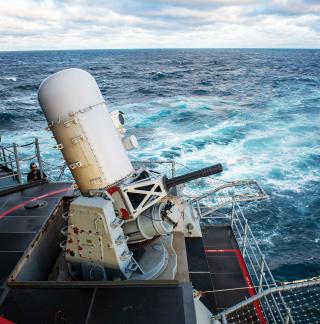Scott Savitz

The growing missile threat is the greatest tactical challenge of the early 21st century. Adversaries ranging from near-peer competitors to rebel groups increasingly can wield highly accurate missiles that can strike ships, ground forces, and key installations. China, Russia, Iran, and North Korea are expanding the size and capabilities of their arsenals, enabling them to unleash devastating fires against the United States and its allies.
At the current state of technological development, missile barrages have a tremendous advantage over existing and near-term defensive capabilities. It is inherently difficult to strike relatively small, high-speed projectiles that can maneuver in three dimensions. Moreover, barrages launched from multiple locations against concentrated targets can overwhelm the defenders’ ability to match them missile for missile, an effect that can be exacerbated by the use of decoys. Endowing potential targets with enough launchers and missiles to counter vast barrages would demand more resources than defense budgets could accommodate.
Complementary ways of countering the missile threat hold promise but face their own limitations. Lasers can provide a higher-volume, less-expensive way of targeting missiles; however, lasers capable of damaging a missile (which is designed to withstand intense heat) have immense power and cooling requirements. They also can be rendered less effective by humidity, precipitation, dust, and other atmospheric conditions.
Railguns that launch hypersonic rounds could target missiles cost-effectively, but they struggle with rail-durability issues. The fact that the rounds are inert means a direct hit is required.
Electronic and cyber attacks can degrade the accuracy and overall performance of missiles, but adversaries likely will employ countermeasures that diminish the efficacy of jamming, spoofing, and malware. Given dynamic actions by both sides, the extent to which any electronic or cyber attack can achieve its intended effect will always be uncertain.
These limitations necessitate novel approaches to help counter the barrages of missiles that can target ships, ground forces, and fixed locations. Rather than trying to target a fast-moving, maneuverable missile, it is possible to create the aerial equivalent of minefields: zones in the sky that inflict damage when a missile passes through them.

Aerial minefields could defeat enough incoming missiles to turn a barrage into a manageable threat. Even were missiles to make it through, any damage inflicted would make them more vulnerable to the Phalanx close-in weapon system. U.S. Navy (Brandon Roberson)
Aerial Minefields
The core of the idea is to use low-cost unmanned aerial vehicles (UAVs) loaded with metal or ceramic shards and have them linger in the vicinity of the assets or areas to be defended. When directed by a ground- or ship-based missile-defense system, the UAVs would move toward the incoming missiles and spread out across the area of approach. As the missiles approached, the UAVs would be directed to release hard, razor-sharp shards, creating hazardous fields for the missiles to pass through. The shards would be dispersed using a combination of gradual release (perhaps over a few seconds) and entropy, resulting in a distributed cloud of material. Naturally, the timing and positioning of release would coincide with the missiles’ arrival, taking gravity and ambient winds into account.
Incoming missiles could attempt to duck and weave their way through these aerial minefields, just as they would against intercepting missiles. However, dodging large, distributed clouds whose locations and edges are difficult to ascertain is much harder than trying to avoid one intensely hot, fast-moving object. Facing a number of such clouds in the approaches to the target, some of the missiles inevitably would fly through appreciable concentrations of shards.
The result would be a series of nasty high-speed collisions. The shards would gouge external surfaces, ripping away the advanced coatings and cladding that protect the core of the missile from the intense heat it generates. Sensors along the surface of the missile would be blinded as hard objects shattered and sliced them. Changes to the surface of the missile—including missing chunks of material, damaged fins, and impaled shards—would distort its aerodynamics in ways that could not have been anticipated by the authors of the missile’s guidance algorithms.
Depending on how deeply the shards penetrate, they could sever critical wires or pipelines, and some could damage fragile information technology (IT) systems. Air-breathing missiles could experience further damage as they suck hard, sharp materials into their engines.
The collective effects would not necessarily destroy the missile, though that likely would happen in some cases. Gouges in heat-resistant external surfaces could cause key parts of the missile to burn up or simply break under the stress of extreme thermal imbalances. Damaged sensors and guidance systems could turn a sea-skimming missile into a sea-diving one. Battered explosive payloads could detonate prematurely, or engines choked with indigestible pieces of hard material could sputter and fail.
However, aerial minefields need not be fatal to missiles to be effective. The foremost value of a nonnuclear missile is its ability to target precisely over long ranges: to home in on a ship, an aircraft, a concentrated ground force, or a critical node within an installation. Unplanned high-speed collisions tend to degrade the performance of sophisticated systems. A missile is much less likely to hit a ship or other target if its aerodynamics have been distorted, its fins have been nicked, its sensors shattered, and its IT systems pierced. The ability to hit a stationary target, let alone a moving one, is a marvel of modern engineering, but a system that runs “like clockwork” will be unlikely to do so if it first strikes a hail of projectiles at hundreds or thousands of miles per hour.
Missiles that have experienced damage from the aerial minefields also would be more vulnerable to complementary defenses. Damage to heat-resistant and radar-stealthy external surfaces would make damaged missiles easier to track: The emergence of infrared-discernible “hot spots” and radar-reflective materials would aid the defenders. Laser weapons could target those hot spots, thereby requiring less power for shorter durations than would be needed to destroy a missile with an intact, heat-resistant surface.
A damaged, less maneuverable missile would be easier to shoot down with a railgun round or an interceptor missile, and a missile in which some electronic warfare systems have been damaged might be more susceptible to jamming or spoofing. If the missile did manage to approach its target, any prior damage would make it more vulnerable to the thousands of rounds fired by the Phalanx close-in weapon system (CIWS) or its land-based equivalent. Above all, the damage inflicted by aerial minefields would reduce the number of missiles that required complementary countermeasures, turning an overwhelming missile barrage into a manageable one.
One advantage of this approach is that it would be particularly effective against hypersonic missiles, whose high speeds make them especially difficult to counter by other means. Aerial minefields would use the missile’s own strength against it: The faster the missile, the more damage the minefield would inflict, with the intensity of the collision increasing with the square of the missile’s speed. A missile going more than Mach 5 (nearly 4,000 miles per hour) that smashed into an aerial minefield likely would be even more deeply pierced and chiseled than a less speedy counterpart.
Low Cost and Simplicity
To make the aerial minefield concept viable, all parts would have to be relatively low cost. Fortunately, this can be done with existing and near-term technology. The system’s “ammunition” could be made of a variety of cheap materials. For just a few hundred dollars per ton, the shards could be made of tungsten or titanium, two extraordinarily hard metals with melting points in the thousands of degrees. Shards of hardened ceramics or low-cost composite materials could be both cheaper and easier to shape.
Regardless of the material selected, varied shapes could be used. Flat shapes with razor-sharp edging could slice away the surface of a missile, while club-like objects would batter its external surfaces, and small pellets could pierce deeply into its body. Elongated shards could be designed to penetrate partway into the missile; their protruding portions would alter the missile’s aerodynamics and, as they became intensely hot, would facilitate the transfer of damaging heat into the missile’s core. Other shards could be coupled using thin, flexible wires or netting that would help to ensnare the missile, causing sharp points to be thrust into its sides. The shards also could be designed to enhance dispersal and increase “hang time,” perhaps bolstered by feather-like appendages or tendrils to influence their aerodynamics and help them maintain particular orientations.
Designing a fleet of UAVs to dispense the shards would be relatively easy. These systems would operate close to whatever they were defending, so while long endurance would be desirable, long range would not be necessary. Because their mission is simple—linger in the environment and then move when directed to specific locations and dispense their payloads—the IT hardware and algorithms required would not be complicated. The UAV would be designed around the release of its load. It might have a large “belly” full of material, with doors that open like a traditional bomb bay. Using a vertical takeoff and landing UAV—perhaps a less complex version of the Fire Scout—would obviate the need for runways.
While data links would need to be secure and reliable, they could be very low bandwidth, as only a few digits are needed to provide positional and timing data. Even if it would be helpful for individual UAVs to periodically relay back to the missile-defense system the wind speed and direction they are experiencing, to better inform their placement, this would increase the bandwidth requirement by only a few digits per minute. The fact that the UAVs would always be close to their home base would make them less vulnerable to jamming or spoofing of their communications links.
The support requirements for these simple UAVs also would be relatively low. Their nonexplosive “ammunition” could be easily stored and handled, with UAVs returning to the ship or base to get fresh supplies after they had dispensed their loads. They would need to be refueled, but other maintenance activities could be limited by designing the UAVs for their one simple mission: relocating as needed and releasing shards.
Existing missile-defense systems would need additional algorithms and protocols to coordinate the UAVs’ behavior, but as they already have copious sensors and software to create and act on a common operational picture, the additional demands would be small. As part of a suite of countermeasures, they would alert the UAVs where to position themselves and when to release debris.

World War II barrage balloons operated in a similar manner to the proposed aerial minefield. They flew over key targets waiting for low-flying aircraft to collide with the thick, heavy cables that tethered them. U.S. Naval Institute Photo Archive
Building on Past Countermeasures
While the concept of aerial minefields might seem novel, it is not a wholly new idea. The barrage balloons used in World War II protected important areas using a broadly similar approach: lingering in the environment, waiting for low-flying aircraft to collide with the thick, heavy cables that tethered them to the ground. However, the use of minefields—broadly defined as distributed, enduring weapon systems that automatically inflict damage when traversed—has been much more extensive and effective in the maritime and ground domains than in the air.
Partly, this reflects fundamental differences among these domains. Aerial devices do not stay aloft indefinitely, they lack the concealment that water or ground can provide, and they need to cover three dimensions rather than two. Using UAVs that linger in the vicinity of the assets to be protected could overcome these challenges. Dispensing low-cost materials on command could create a temporary three-dimensional minefield expansive enough to prevent a racing missile from being able to easily avoid it. While space is vast, when the incoming missile is headed for known high-value targets, the dimensions of the problem shrink considerably. In the western Pacific and other naval-centric theaters, in which the environment is relatively uncluttered, the missiles’ intended targets are easy to identify: fleets at sea and specific island bases.
In many ways, aerial minefields are akin to the Phalanx CIWS, since both entail the shotgun-like distribution of large quantities of relatively small interceptors. However, aerial minefields have several advantages. By inflicting damage miles from the target, rather than within the last mile or two, they provide precious seconds for the missile’s systems to experience cascading failures. They also can cover wider areas and address multiple missiles simultaneously. This is not to discount the importance of the Phalanx system, but to recognize that a complementary approach applied at a greater distance could help to reduce the risk of it being oversaturated.
Issues To Be Addressed
The aerial minefield concept has limitations. An obvious vulnerability is that the attacker could launch missiles to target the UAVs themselves, particularly given that these UAVs are not meant to be stealthy, speedy, or armed. However, firing a precision long-range missile to target a relatively cheap UAV would be a huge waste of resources for the attacker. Like minefields in other domains, these systems would be much more challenging and costly to counter than to emplace.
Another consideration is that shards and parts of the damaged missile would rain down on the area beneath the release point. This would not be much of an issue at sea, which is why the system is desirable for both fleet defense and securing island bases; however, it would present problems on land. The missile-defense system could take this into account, directing UAVs to release their loads along the missile paths but between populated areas.
In addition, space, fuel, and personnel are always in high demand at the edge of the battle zone, so commanders may be reluctant to be burdened with additional systems that do not directly add to long-range combat power. But the requirements of aerial minefields would be modest compared with those of other missile-defense systems. They would not have the space demands of missiles and launchers or the intense power and cooling demands of lasers and railguns and would require few personnel.
Aerial minefields could play a valuable role in defending against barrages of precision missiles. While they would not supplant existing and emerging countermeasures, they would offer a low-cost complement that would defeat some missiles and make others more vulnerable to complementary defenses. Adversaries would lose multi-million-dollar missiles to cheap metal or ceramic shards, putting the United States on the right side of the cost curve. By rendering the environment itself hostile to incoming missiles, these systems could enable warfighters to survive and win in the coming battlefields of the 21st century.
No comments:
Post a Comment